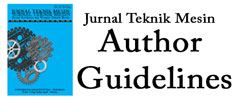Pengaruh Variasi Tekanan Hot Press pada Kekuatan Biokomposit Biji Salak - Polipropilena
DOI:
https://doi.org/10.9744/jtm.19.2.36-39Keywords:
Flexural strength, area density, salacca zalaccaAbstract
Biokomposit adalah material yang telah banyak dimanfaatkan oleh industri otomotif di negara maju terkait dengan peraturan ketat menyangkut isu penghematan energi dan lingkungan karena emisi gas buang serta material yang ramah lingkungan. Limbah alam lignoselulosa memiliki potensi menjadi bahan penguat untuk biokomposit. Telah banyak penelitian yang menggunakan serat atau partikel bahan alam untuk membuat biokomposit polimer bertujuan peningkatan kekuatan, ringan, serta ramah lingkungan. Penelitian ini menggunakan biji buah salak yang biasanya dibuang, dihancurkan menjadi bentuk serbuk dengan ukuran < 100 yang dimanfaatkan sebagai filler penguat untuk biokomposit matriks polipropilena (PP). Dalam penelitian ini digunakan proses hot press dengan campuran biji salak dan PP dari tiga variasi komposisi dan tiga variasi tekanan hot press. Variasi komposisi berupa tiga rasio persentase berat serbuk biji salak /PP, yaitu 20/80, 25/75, dan 30/70 dan diberi variasi tekanan hot press 0,3; 0,35; dan 0,4 MPa. Tebal dan gramasi semua sampel diukur sebelum dilakukan pengujian flexural. Hasil pengujian flexural (ASTM D790-17) menunjukkan bahwa kekuatan flexural meningkat dengan penambahan kandungan filler demikian pula dengan peningkatan tekanan hot press. Kekuatan tertinggi sebesar 45,46 MPa yang didapat dari sampel dengan 30 % berat serbuk biji salak dengan tekanan hot press 0,4 MPa. Kekuatan flexural dan gramasi sampel memiliki nilai lebih baik daripada komposit woordboard yang saat ini digunakan oleh industri otomotif.
References
U.S. Environmental Protection Agency, Office of Transportation and Air Quality, “EPA and NHTSA Set Standards to Reduce Greenhouse Gases and Improve Fuel Economy for Model Years 2017-2025 Cars and Light Trucks,” (pdf file, 2012).
http://eur-lex.europa.eu/legal-content/EN/TXT/ PDF/?uri=CELEX:02000L0053-20130611& qid=1405610569066&from=EN (retrieved on 19 August 2017)
https://www.dieselnet.com/standards/jp/fe.php (retrieved on 19 August 2017)
http://www.transportpolicy.net/standard/china-light-duty-fuel-consumption/ (retrieved on 19 August 2017)
Pervaiz. M., Sain, M.M, 2003, Sheet-molded Polyolefin Natural fiber Composites for Automotive Applications, Macromolecular Materials and Engineering, 288, pp. 553-557.
Dányádi, L., Renner, K., Móczó, J., Pukánszky, B., 2007, Wood Flour Filled Polypropylene Composites: Interfacial Adhesion and Micromechanical Deformations, Polymer Engineering and Science, 47,8, pp 1246-1255.
Anggono, J., Sugondo, S., Alim, R., Purwaningsih, H., dan Wibawa, A., 2018, Performance and Evaluation of Low Cost Sugarcane Bagasse – Polypropylene Biocomposites as Candidate Material for Automotive Parcel Tray, Material Science Forum, 923, pp 40-46.
Anggono, J., Farkas, Á.E., Bartos, A. Móczó, J., Antoni, Purwaningsih, H., Pukánszky, B., 2019, Deformation and Failure of Sugarcane Bagasse Reinforced PP, European Polymer Journal, 112, pp 153-160.
Bartos, A., Utomo, B. P., Kanyar, B., Anggono, J., Soetaredjo, F. E., Móczó, J., Pukánszky, B., 2020, Reinforcement of polypropylene with alkali-treated sugarcane bagasse fibers: Mechanism and consequences, Composite Science and Technology, 200, 108428.
Havas, Z., Mezei, G., Hamzók, T., 2018, Natural Fillers in Polypropylene: Comparison of Two Different Filler Types, poster exhibition in 4th International BiPoCo conference.
Han, K. G., Anggono, J., Jonathan, P., 2019, The Reinforcing Effect of Sugar Palm Fiber on PP, International Journal of Industrial Research and Applied Engineering, 25, 1, pp 23-26.
Anggono, J., Victorio, H., Chrisnanto, L. A., The Properties of Snake Fruit and Kluwak Pits Reinforced PP: Exploring their Application for Automobile Part, AIP Conference Proceedings (in press).
Pukánszky, B., Particulate Filled Polypropylene: Structure and Properties in Polypropylene: Struc-ture, Blends, and Composites–Composites, 1995, Chapman and Hall, London, UK, pp. 1–70.
Chang, L. J., Young , J. H., Jiang, B.C., Jang, J.S.C., Huang, J.C., Tsao, Chi Y.A., 2007, Mechanical Properties of the Mg-Based Amorphous/Nano Zirconia Composite Alloy, Materials Science Forum, 539-543, pp 925-930.
Downloads
Published
Issue
Section
License
Jurnal Teknik Mesin is publihed by the Mechanical Engineering Department, Petra Christian University, Indonesia
![]()
All articles and their contents are published and distributed under the international license of Creative Commons Attribution License (CC BY).



















